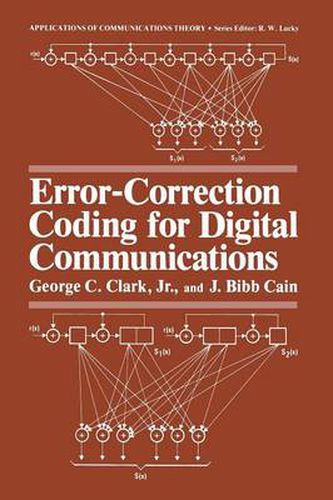Readings Newsletter
Become a Readings Member to make your shopping experience even easier.
Sign in or sign up for free!
You’re not far away from qualifying for FREE standard shipping within Australia
You’ve qualified for FREE standard shipping within Australia
The cart is loading…






This title is printed to order. This book may have been self-published. If so, we cannot guarantee the quality of the content. In the main most books will have gone through the editing process however some may not. We therefore suggest that you be aware of this before ordering this book. If in doubt check either the author or publisher’s details as we are unable to accept any returns unless they are faulty. Please contact us if you have any questions.
Error-correction coding is being used on an almost routine basis in most new communication systems. Not only is coding equipment being used to increase the energy efficiency of communication links, but coding ideas are also providing innovative solutions to many related communication problems. Among these are the elimination of intersymbol interference caused by filtering and multipath and the improved demodulation of certain frequency modulated signals by taking advantage of the natural coding provided by a continuous phase. Although several books and nu merous articles have been written on coding theory, there are still noticeable deficiencies. First, the practical aspects of translating a specific decoding algorithm into actual hardware have been largely ignored. The information that is available is sketchy and is widely dispersed. Second, the information required to evaluate a particular technique under situations that are en countered in practice is available for the most part only in private company reports. This book is aimed at correcting both of these problems. It is written for the design engineer who must build the coding and decoding equipment and for the communication system engineer who must incorporate this equipment into a system. It is also suitable as a senior-level or first-year graduate text for an introductory one-semester course in coding theory. The book U Ses a minimum of mathematics and entirely avoids the classical theorem/proof approach that is often seen in coding texts.
$9.00 standard shipping within Australia
FREE standard shipping within Australia for orders over $100.00
Express & International shipping calculated at checkout
This title is printed to order. This book may have been self-published. If so, we cannot guarantee the quality of the content. In the main most books will have gone through the editing process however some may not. We therefore suggest that you be aware of this before ordering this book. If in doubt check either the author or publisher’s details as we are unable to accept any returns unless they are faulty. Please contact us if you have any questions.
Error-correction coding is being used on an almost routine basis in most new communication systems. Not only is coding equipment being used to increase the energy efficiency of communication links, but coding ideas are also providing innovative solutions to many related communication problems. Among these are the elimination of intersymbol interference caused by filtering and multipath and the improved demodulation of certain frequency modulated signals by taking advantage of the natural coding provided by a continuous phase. Although several books and nu merous articles have been written on coding theory, there are still noticeable deficiencies. First, the practical aspects of translating a specific decoding algorithm into actual hardware have been largely ignored. The information that is available is sketchy and is widely dispersed. Second, the information required to evaluate a particular technique under situations that are en countered in practice is available for the most part only in private company reports. This book is aimed at correcting both of these problems. It is written for the design engineer who must build the coding and decoding equipment and for the communication system engineer who must incorporate this equipment into a system. It is also suitable as a senior-level or first-year graduate text for an introductory one-semester course in coding theory. The book U Ses a minimum of mathematics and entirely avoids the classical theorem/proof approach that is often seen in coding texts.